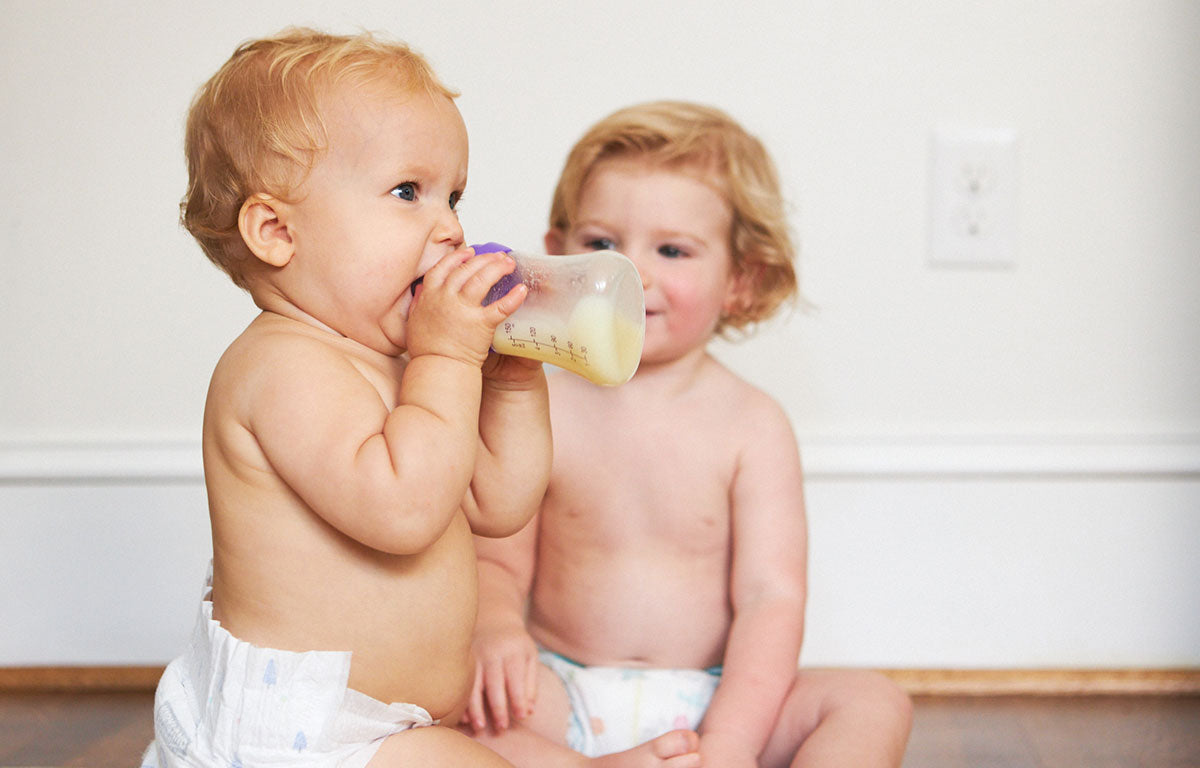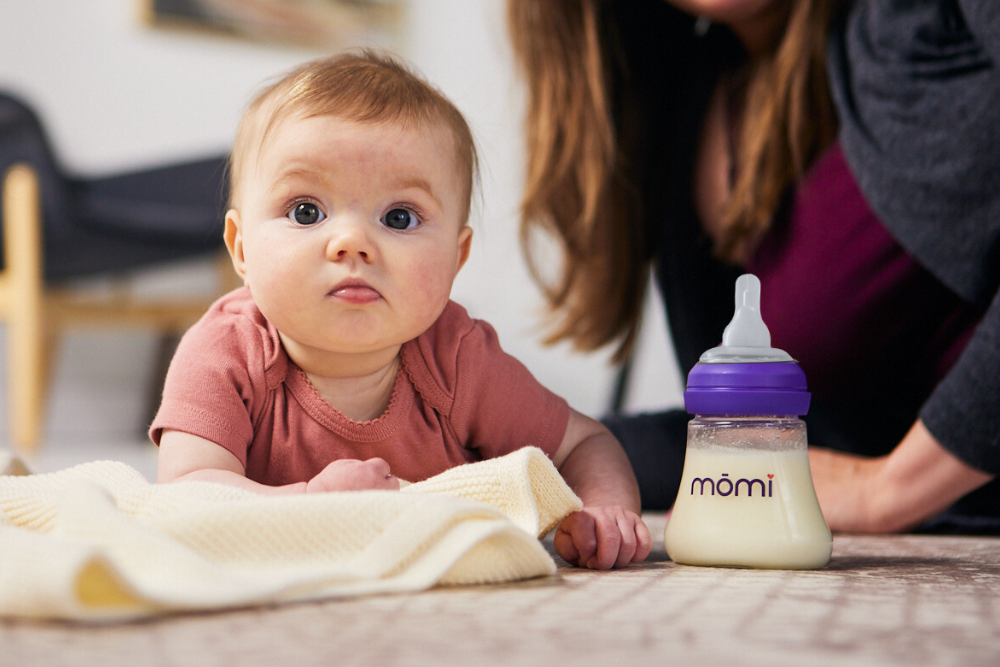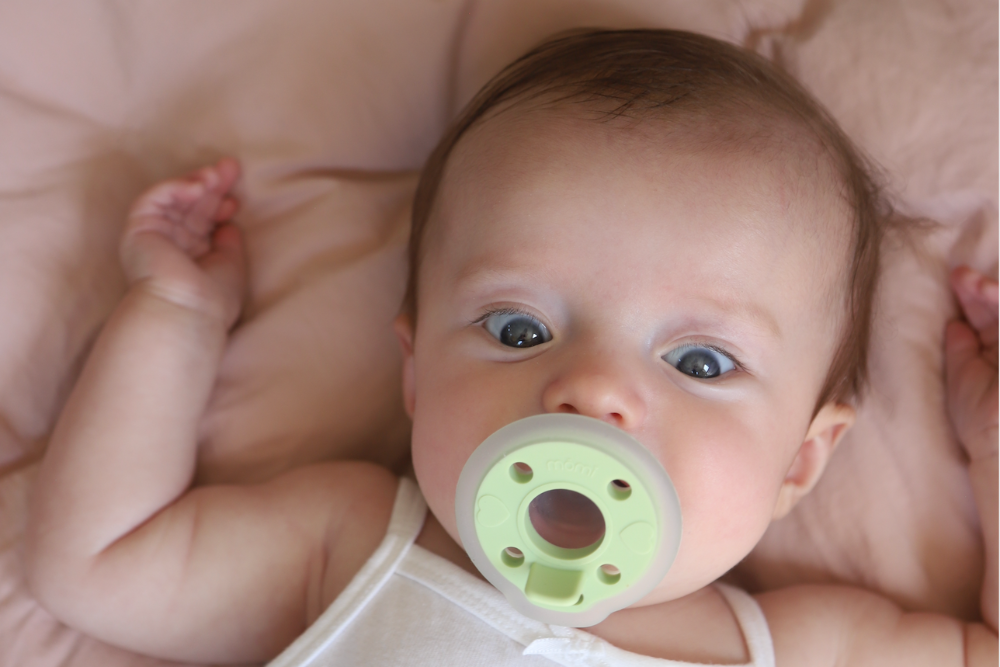It is quite common for moms to wonder if their baby is getting enough to eat. Although every baby is unique, there are some basic guidelines you can follow to help assess if your baby is consuming enough throughout the day.
It’s important to note that the guidelines below are averages, and food intake varies among babies. Overall, we recommend that you look for a balance between the recommended baby feeding amount, and your baby’s real-time hunger cues to determine if your baby is getting enough to eat and when you should feed your baby. We do not advise sticking to too rigid of a feeding schedule as that would not allow you to adjust to baby’s various developmental stages, and runs the risks of over- or underfeeding your baby. Moreover, weight and growth check-ins during the first year of your baby’s life can help inform you on whether you’re offering the right amount of breast milk or formula, and whether you would need to adjust your feeding practices to make sure your child’s weight gain is on track.
Let’s discuss in more detail how much your baby should eat in general, how to recognize hunger and satiety cues, how to best support your baby during growth spurts, and how to prevent overfeeding.
How many ounces of breast milk or ounces of formula should a baby eat?
“On average, a baby under 12 months should be eating around 24 ounces of breast milk or 24 ounces of formula in 24 hours,” Dr. Meg Alden, a pediatrician in Winston-Salem, NC and mōmi’s Chief Medical Officer, said.
“As a baby’s stomach grows and adapts, feedings get larger and less frequent. So a newborn baby would eat 2 ounces every 2 hours. A younger infant (2-6 months old) would eat 4 ounces every 4 hours. An older infant (6-12 months old) would eat 6 ounces every 6 hours. After 12 months a baby’s primary source of nutrition switches to solid food.”
Keep in mind that, although a baby goes through growth spurts (more on that below), this 2 every 2, 4 every 4, and 6 every 6 schedule is easy to remember and can serve as a basic guideline for your feeding schedule. Consequently, over the course of 24 hours, you should expect to feed your baby around 24 ounces of formula or breast milk. While this is an average benchmark, you should be attentive to your baby’s hunger cues and growth milestones to fine-tune your feeding schedule for your baby.
Bottle-Fed and Formula-Fed Baby Feeding Chart
Newborn Stage (Birth to 2 months)
- Average Ounces Per Feed: 2 ounces
- Average Frequency of Feeds: Every 2 hours
- Average Total Feeds Per Day: 12
Younger Infant Stage (2-6 months)
- Average Ounces Per Feed: 4 ounces
- Average Frequency of Feeds: Every 4 hours
- Average Total Feeds Per Day: 6
Older Infant Stage (6-12 months)
- Average Ounces Per Feed: 6 ounces
- Average Frequency of Feeds: Every 6 hours
- Average Total Feeds Per Day: 4
In addition, according to the American Academy of Pediatrics (AAP), solid foods should be introduced to your baby’s diet once he or she turns 6 months. His or her primary source of nutrition, however, should continue to be breast milk or formula until one year of age.
Breastfed Baby Feeding Chart
Newborn Stage (Birth to 2 months)
- Put Baby to Breast: Every 2 hours
- Average Nursing Sessions Per Day: 12
Younger Infant Stage (2-6 months)
- Put Baby to Breast: Every 4 hours
- Average Nursing Sessions Per Day: 6
Older Infant Stage (6-12 months)
- Put Baby to Breast: Every 6 hours
- Average Nursing Sessions Per Day: 4
Using a Diaper Count to Determine if Your Baby is Getting Enough to Eat
A typical newborn wets his or her diaper around 8 times per day. Consistently wet diapers suggest that your baby is well-hydrated and taking in an appropriate amount of calories. A healthy wet diaper count could be anywhere from 5-10 diapers per day.
Keep a journal of every wet diaper to help you feel comfortable when talking to your pediatrician about whether or not your baby is getting enough ounces of breast milk or ounces of formula.
Counting poop or dirty diapers is a less reliable way to track whether or not your baby is drinking enough ounces of breast milk or ounces of formula. This is because some babies poop once a day, while others might poop once a week. Whether or not they are drinking breast milk or drinking formula can influence their frequency of dirty diapers.
Therefore, don’t be alarmed or worried that your baby is underfed just because he or she hasn't pooped in several days. Count his or her wet diapers and use other cues such as hunger cues to determine if your baby has had enough to eat.
How to Recognize Hunger Cues
First signs of hunger in a baby
-
Smacking or licking their lips
-
Opening and closing their mouth
-
Sucking on their lips, tongue, hands, fingers, toes, toys, or clothing
Signs that your baby is ready to eat
-
Rooting around on your chest
-
Trying to position for nursing
-
Fidgeting or squirming
-
Hitting you on the arm or chest repeatedly
-
Fussing or breathing fast
Signs that your baby is overly-hungry
-
Moving his or her head frantically from side to side
-
Crying and turning red
-
Acting extremely agitated with jerky movements
Infant Growth Spurts and Cluster Feeding
If your typically happy newborn suddenly wants to nurse 18 hours a day, isn’t sleeping well, and seems fussier than normal – your baby may be going through a growth spurt.
During a growth spurt, your baby is packing on more weight than usual and increasing body length and head circumference. Because babies tend to grow simultaneously in these three areas – height, weight, and head circumference– you might notice that your baby’s sleepers or onesies fit tighter than normal after he or she experiences a growth spurt. A jump in newborn percentiles could also indicate a baby growth spurt.
When do growth spurts happen?
Baby growth spurts can happen at any time, but they usually occur around these periods:
- Between 2-3 weeks
- Between 4-6 weeks
- 3 months
- 6 months
- 9 months
How does feeding change during a growth spurt?
During a growth spurt, your baby will want to eat more frequently. A breastfed baby might start fussing 30 minutes after a feeding, instead of waiting until the two-hour mark. This can mean that you go from nursing 12 times a day to well over 20 times. Hang in there!
Breastfeeding on demand during a growth spurt is called cluster feeding. Cluster feeding is exhausting, but it does wonders for your milk supply. Cluster feeding triggers your body to increase the amount of breast milk that you produce, since breast milk is made on a supply and demand basis.
With your baby demanding milk every 30 minutes, your body knows that it needs to keep milk coming. Therefore, these growth spurts can act as “superchargers” for your supply.
Thankfully, for younger infants, growth spurts only last one or two days each time. Keep putting your baby to breast, and give lots of good cuddles and skin-to-skin contact time to help your baby make it through comfortably.
How to Recognize That Your Baby is Full
Below are signs to look for in your baby to determine whether he or she is full after breastfeeding or bottle-feeding.
Signs your baby is full
-
Turning away from the breast or the bottle
-
Relaxing their lips to no longer suck
-
Closing their mouth
-
Unclenching and opening their hands
-
Pushing food away (older babies)
How to Avoid Overfeeding Your Baby
Overfeeding is an important and common issue that parents need to pay attention to. In effect babies who are fed formula or breast milk out of traditional bottles are more likely to be overfed. This is because parents can control (and increase) the number of ounces of formula or ounces of breast milk offered.
“I’ve found that parents will see their baby acting hungry, and will keep feeding until their baby acts full,” Dr. Meg Alden, mōmi’s Chief Medical Officer, said. “My theory is that passive feeding, where a baby might be drowsy and continuing to suckle, will have a baby stretching their stomach beyond what is necessary. Just like in adults, you can overeat, your stomach will stretch, and you might not realize it until a little bit later. A baby's stomach can also stretch beyond comfort. Passive feeding happens all the time. It comes from a place of love. Parents don’t want their baby to be hungry, they don’t want their baby to cry, so they continue to make bottles bigger and bigger. And while there is certainly a bell curve on how much a baby can drink, the 24 ounces in 24 hours guideline can ensure you aren’t giving too much.”
It’s always a good idea to talk to your pediatrician about overfeeding concerns. If your baby’s weight is in a healthy percentile, and if your baby is eating roughly the recommended amount of ounces of formula or ounces of breastmilk per day, try not to offer additional bottles as a frequent soothing technique.
The mōmi nipple, which is designed to replicate natural physiology, allows babies to regulate the flow of milk during feeding. When babies raise their tongues to swallow, they compress the mōmi nipple and stop the milk flow. In contrast, babies are unable to stop the continuous flow of milk through the hollow nipple in traditional feeding bottles, which often leads to choking and overfeeding. Therefore, the choice of feeding bottles can also play an important role in helping you avoid overfeeding your baby.
Do’s and Don’ts for Feeding
-
Don’t get stressed if your baby wants to eat slightly more or slightly less than what is recommended.
-
Don’t track poop diapers as a way to measure if your baby is getting enough to eat.
-
Don’t wait until your baby is extremely hungry to offer breast milk or formula.
-
Don’t pressure your baby to finish an entire bottle.
-
Don’t use passive feeding as a way to constantly calm your baby down.
-
Do use averages as guidelines for how many ounces and how frequently to feed your baby.
-
Do track the wet diaper count to ensure that your baby is adequately hydrated and fed.
-
Do begin preparing for a feed upon seeing the first signs of hunger cues.
-
Do allow your baby to turn away once he or she is full.
-
Do use alternative strategies such as offering pacifiers (once breastfeeding is well-established), playing music, and rocking to help satiate your baby and avoid overfeeding.




